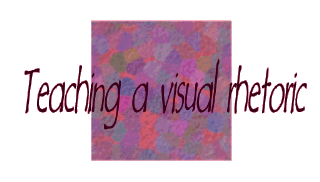The following semester I designed
a
template
, hoping this would help make the connection between academic literacy
and electronic literacy. I asked my students to add their text, embedded
links, and images using Microsoft Frontpage, a WYSIWYG that
allows users to design Web sites without actually learning
any code. This time I also assigned a grade for their efforts,
as the format was very similar to the traditional written style.
I believed the added structure
was going to alleviate student concerns and the overall chaos
of computer lab days. What I discovered, however, surprised me. Their
level of enthusiasm was much lower; only the technologically savvy
students seemed daring and confident even though I offered a template
to guide them. In addition, all of their Web sites were
too similar to my example; they were only physical imitations of
my form, mere copies lacking any true visual literacy at all. I had
taught them little if any principles of visual design, and I did
not allow for individual creativity. As a matter of fact, only
one student chose to incorporate visual imagery that
was not a point-and-click "theme" option in the Frontpage program.
Most importantly, very few students truly understood the concept
of audience addressed writing. They were still writing to please the
instructor, still imitating what they thought the academy wanted them
to say. There was no real connection to the idea that writing is a form
of communication, and that the electronic space is a place which evokes
a different kind of authorship, one that must incorporate the increasing
demands of an empowered reader.
Despite all my efforts, I had failed again. What was I doing
wrong? I continually asked myself hard questions about current practices
and how they differed from the electronic marketplace. I knew that visual
rhetoric had to be taught in an ongoing fashion, but I also
knew that the academy expected students to develop traditional critical
writing skills. I knew I had to not only understand the theory behind
the practice, but had to develop a practice that was sound, holistic;
I decided to bend my traditional practices to incorporate acceptable
electronic principles of design. I realized that my students could
not write traditional essays in class and then slap them up onto
the web at the end of the semester and call that visual rhetoric. Elements
of both styles, if they both must be taught, had to be taught concurrently,
and well as their varying literacies. I contemplated whether traditional
essays could be used as sample texts to be altered for the web during
the early part of a semester, and decided that in the future I would
just forego the separation of essay and web, and let the electronic
portfolio take the place of the traditional written portfolio.
RESEARCHING THE SUBJECT...
Additionally, Phil Anderson and Anne
Aronson give reasons why some traditionalists are opposed
to incorporating a delivery analysis in their curriculums. They
believe the “static, form-centered approach to writing” for
which we all are accustomed, contains certain “precepts” that
“help to explain why visual images are so marginalized in academic
writing” (118). Furthermore, they claim that the current-traditional
method only promotes reader-based prose, writing that summarizes
disciplinary texts and ignores personal knowledge. They argue
that this practice leaves students with the misconceived notion
that knowledge is to be read, not discovered or created by the students
themselves (119). I agree, and I’d like to add “not visualized”
or “conceptualized” through a multimedia presentation. So often students
have admitted to making a career of writing “flat” meaningless
essays that fit an assignment intellectually but lacked any passion
or personal commitment to the particular subject. Anderson and Aronson
believe that this autonomous text “is an ideological artifact, not
an adequate explanation of what really goes on in writing and reading,”
yet they like to point out that it “shapes” our everyday practice
of teaching writing. In short, the academic community still privileges
the word over the image (119). “The condensed, multi-layered
nature of the image is antithetical to the long, linear reach of
the academic essay” (120). Anderson and Aronson believe that Blair’s
influence on the academy, his “refined taste” and appreciation for
canonical literature, has fostered a kind of “intellectual snobbery
that continues today within the academy.... The implication is that
incorporating visual imagery and design into the academic essay may taint
it; it might become something that can be thrown up on the Web next to
advertisements for miniature camcorders” (123).
|
